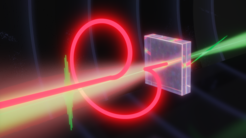Invisible Circular Light Waves Accurately Measured with Quartz Crystals
The THz Structural Dynamics group of the Department of Physical Chemistry at the Fritz Haber Institute has made a significant advancement in light research, as detailed in their recent publication in the journal Optica, titled „Quartz as an Accurate High-Field Low-Cost THz Helicity Detector.” Their work introduces a fast, cost-efficient, and precise technique for analyzing complex waveforms of Terahertz (THz) light, a part of the far-infrared spectrum that is invisible to the naked eye and most detectors. Strong THz laser pulses are further crucial for exploring and manipulating fundamental properties of materials at ultrafast speeds.

THz light refers to electromagnetic waves with frequencies in the terahertz range, sitting between microwave and infrared on the electromagnetic spectrum. This light is of great interest for scientific research because it can penetrate various materials without causing damage, making it useful for imaging and spectroscopy in a wide range of applications, from security scanning to chemical analysis.
One challenge in THz research has been the accurate measurement of this light, especially when it is highly intense. High-field THz pulses can overwhelm conventional detectors, making it difficult to accurately study its properties such as amplitude (the strength of the light wave), phase (the relative position of the peaks and troughs of the wave), and polarization states (the direction in which the light field oscillates). Polarization states, in particular, can be complex, with the electric field of the light rotating in patterns that can resemble corkscrews.
The research team has developed a method using simple quartz plates to overcome these challenges. Quartz, a widely available and inexpensive material, has been shown to effectively measure the amplitude, phase, and complex polarization states of intense THz fields without the saturation issues that plague conventional detectors. This is achieved by exploiting the way intense THz electric field spikes affect the refractive index of quartz, allowing for precise measurements of the evolution of the light field’s direction.
This breakthrough is significant because it provides a method that is not only accurate but also accessible due to its low cost and rapid implementation. It opens up new possibilities for using THz light in research and industry, enabling more detailed study and control over novel material properties at speeds that were previously difficult to achieve.
Into the Depth: More Scientific Insights
In the presented method, intense THz electric field spikes produce a modulation of the refractive index of a simple quartz plate. Although amplitude- and phase-resolved THz detection via this electro-optic effect is well established, conventional THz detectors easily saturate at field strengths on the order of 1 MV/cm. These enormous field strengths, about 100 times higher than the DC electric breakdown field of air, are required to drive crystal lattices in a controlled manner that modulates the material properties. The group shows how simple quartz plates can be used to precisely measure such high THz electric fields by determining the quartz detector response function.
Thereupon, the researchers deduct a swift and simple protocol that uses the specific quartz symmetry to extract the polarization state of the high-field THz pulse. This technique is fast, reliable and, most importantly, allows the detection of complex THz polarization patterns, where the THz electric field may follow corkscrew trajectories as shown in the picture above. In future, such THz fields will enable selective energy transfer to chiral material resonances and will help to precisely exchange angular momentum between light and matter in the THz spectral range.
In addition, the quartz detector material is widely available at a fraction of the cost of conventional THz detectors. This is especially relevant for both academic and industrial applications, and allows THz time-domain spectrometers to be converted into cost-efficient THz ellipsometers. Overall, the presented method is key to future efforts employing THz light’s angular momentum to drive polarization-sensitive quasiparticles and to control advanced material properties at ultrafast speeds.
Original publication:
